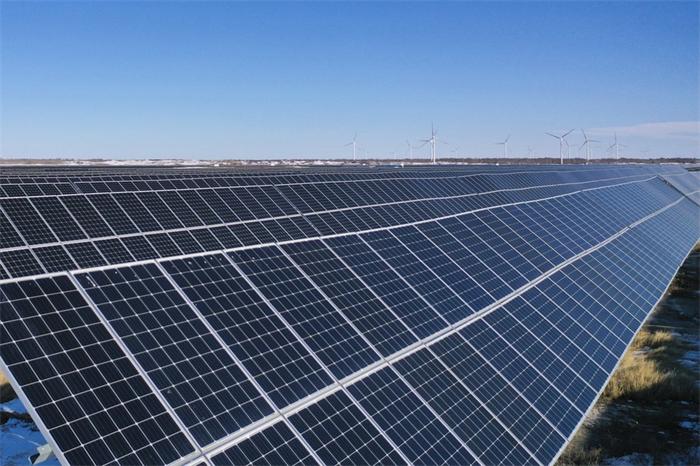
Photo taken on Dec. 3, 2021 shows a photovoltaic power station in Wulanhua Town, Baicheng City of northeast China's Jilin Province. (Photo by Zhang Yubo/Xinhua)
BEIJING, Nov. 24 (Xinhua) -- With construction of bases for new energies such as wind power and photovoltaic (PV) power speeding up in recent years, China sees increasing energy storage demands.
Energy storage enterprises are facing great opportunities, with surging orders for related products since the start of this year. Some businesses even have orders scheduled for the middle of 2023.
Industry insiders have expressed confidence in the long-term development of China's energy storage market backed by policy support and rising demands.
-- Surging orders
As China strives to realize the goal of peaking carbon dioxide emissions by 2030 and achieving carbon neutrality by 2060, its clean energies such as wind power and PV power have seen large-scale development. However, the volatility and intermittency of clean energy sources are posing great challenges to the safe and reliable operation of power system. Energy storage, by storing energy from renewables and then releasing it when needed, in response to the ups and downs of daily electricity consumption, can ensure the smooth operation of electricity grids, thus becoming an indispensable part of new type of power system, said industry insiders.
Statistics show that in the first three quarters of 2022, China's newly installed capacity of new operating energy storage projects reached 963.7 MW, jumping 120 percent year on year.
Against this backdrop and supported by policies, energy storage enterprises are receiving surging orders.
For example, Kehua Digital Energy based in Zhangzhou, east China's Fujain Province saw this year's global orders soar several times compared with last year. Its production for household hybrid PV and storage converters for overseas market is arranged until half a year later, said Zeng Chunbao, general manager of the company's technology center.
In the market demand side, high energy prices in Europe lead to a surge in demands for energy storage, especially for household energy storage equipment.
Workers are crashing schedule in response to this year's full orders requiring supporting energy storage equipment for household rooftop PV power generation. Production for some of the orders cannot be realized until the end of next year, according to a staff of an energy storage enterprise in Suzhou, east China's Jiangsu Province.
-- Policy support
China has unveiled a series of policies to push forward development of its energy storage sector since the beginning of 2022.
In March, the National Development and Reform Commission (NDRC) and the National Energy Administration (NEA) jointly released a plan for developing a modern energy system during the 14th Five-Year Plan period from 2021 to 2025, which proposes to accelerate large-scale application of new energy storage technologies.
Localities have also taken measures to deploy new energy storage systems at a faster pace.
Southwest China's Guizhou Province aims to make the installed capacity of new energy storage to no less than 1 GW by 2025 and raise that figure to about 4 GW by 2030, according to an implementation plan for peaking carbon dioxide emissions issued by the province on November 17.
So far, at least 24 provinces, regions and cities in China have introduced policies to make construction of supporting energy storage system a precondition for power grid connection or approval of new energy projects. Some provinces even pointed out that the installed capacity of energy storage should reach 10 percent or even 20 percent of the total installed capacity of new energy projects.
Meanwhile, more than 20 provinces and cities have rolled out subsidy policies to support the development of energy storage industry since 2018.
For example, Changsha city in central China's Hunan Province recently made it clear in a policy to grant operators of energy storage power plants incentives as much as 0.3 yuan for per kWh electricity provided, with the annual subsidies for a single operator not exceeding three million yuan.
Spurred by relevant policies, China's energy storage industry is expected to enter a fast growth period. Investment in the sector is likely to reach 450 billion yuan in 2025 and hit 1.3 trillion yuan in 2030, according to projections by Everbright Securities.
-- Production expansion
As demands for energy storage skyrocket, relevant enterprises are ramping up production.
According to data by China Securities Journal, in the first nine months, 26 energy storage batteries and power batteries-related production expansion projects were launched in China, with a total investment of nearly 300 billion yuan and a total production capacity of 820 GWh.
In order to seize market opportunities, an increasing number of enterprises are making cross-sector investment in energy storage industry.
For example, Sunwoda Electronic Co., Ltd. (300207.SZ), whose main business is production and sales of lithium battery cells and modules, announced on September 21 that it planed to invest 21.3 billion yuan in a 50 GWh power battery and energy storage battery project in Yiwu, east China's Zhejiang Province. The company said earlier this month that it had started building corresponding production lines.
Likewise, Zhiguang Electric Co., Ltd. (002169.SZ), a power electronic technology research and product application provider, said that it had begun constructing a 1.5 GWh energy storage production line project in Nansha district of Guangzhou, south China's Guangdong Province, with the long-term goal of expanding production capacity to 12 GWh. (Edited by Su Dan with Xinhua Silk Road, sudan@xinhua.org)




 A single purchase
A single purchase









